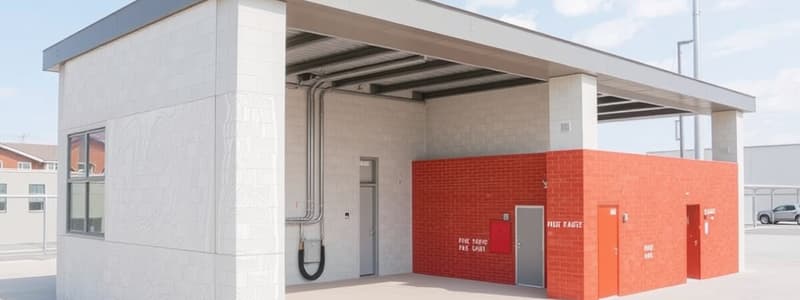Podcast
Questions and Answers
What was a significant outcome of the Great Baltimore Fire of 1904?
What was a significant outcome of the Great Baltimore Fire of 1904?
- The formation of the International Code Council (ICC)
- The ban on wood and plaster chimneys in New York City
- The establishment of the National Fire Protection Association (NFPA)
- The creation of the first national building code by the insurance industry in 1906 (correct)
Which organization was established in 1873 and is now known as the International Association of Fire Chiefs?
Which organization was established in 1873 and is now known as the International Association of Fire Chiefs?
- National Fire Protection Association (NFPA)
- Southern Building Code Congress International (SBCCI)
- Building Officials and Code Administrators International (BOCA)
- National Association of Fire Engineers (NAFE) (correct)
What is the role of the National Fire Protection Association (NFPA) in fire protection?
What is the role of the National Fire Protection Association (NFPA) in fire protection?
- Issuing standards like NFPA 13 for sprinkler systems and the National Electrical Code (correct)
- Regulating fire prevention activities in existing buildings
- Enforcing local building regulations
- Developing model building codes
Which organization developed the Uniform Building Code, used primarily in the West and Southwest of the United States?
Which organization developed the Uniform Building Code, used primarily in the West and Southwest of the United States?
What was the purpose of creating the International Code Council (ICC) in 1994?
What was the purpose of creating the International Code Council (ICC) in 1994?
Which of the following best describes the role of building codes?
Which of the following best describes the role of building codes?
Which organization primarily focuses on enforcing local building regulations?
Which organization primarily focuses on enforcing local building regulations?
What is the main distinction between building codes and fire codes?
What is the main distinction between building codes and fire codes?
What is a primary consideration for determining building area and height limits in construction codes?
What is a primary consideration for determining building area and height limits in construction codes?
What is an egress 'Exit'?
What is an egress 'Exit'?
What is the primary purpose of panic hardware?
What is the primary purpose of panic hardware?
What must fire escapes on older buildings meet to be considered safe?
What must fire escapes on older buildings meet to be considered safe?
Which occupancy classification includes structures like barns, carports, and greenhouses?
Which occupancy classification includes structures like barns, carports, and greenhouses?
Why are exit signs and emergency lighting required in buildings?
Why are exit signs and emergency lighting required in buildings?
What does NFPA 5000 focus on?
What does NFPA 5000 focus on?
Which type of occupancy classification would likely require the most stringent fire protection measures?
Which type of occupancy classification would likely require the most stringent fire protection measures?
What is the significance of the 'Occupant Load' in building codes?
What is the significance of the 'Occupant Load' in building codes?
Which type of construction typically has noncombustible exterior walls but combustible interior elements?
Which type of construction typically has noncombustible exterior walls but combustible interior elements?
Which statement correctly distinguishes between building codes and fire codes?
Which statement correctly distinguishes between building codes and fire codes?
Which tragic event in 1984 highlighted the need for changes to building and fire codes?
Which tragic event in 1984 highlighted the need for changes to building and fire codes?
How frequently are building and fire codes typically updated?
How frequently are building and fire codes typically updated?
Which organization is responsible for developing the NFPA 5000 model building code?
Which organization is responsible for developing the NFPA 5000 model building code?
What is the purpose of ASTM E119?
What is the purpose of ASTM E119?
What aspect do building codes typically regulate?
What aspect do building codes typically regulate?
What is the primary focus of fire codes?
What is the primary focus of fire codes?
What characterizes Type I construction?
What characterizes Type I construction?
Which type of construction is defined by noncombustible exterior walls and combustible interior elements?
Which type of construction is defined by noncombustible exterior walls and combustible interior elements?
Which type of construction involves large wooden beams and columns along with noncombustible exterior walls?
Which type of construction involves large wooden beams and columns along with noncombustible exterior walls?
What is the least fire-resistant type of construction?
What is the least fire-resistant type of construction?
Which occupancy classification pertains to buildings used for worship, entertainment, or dining?
Which occupancy classification pertains to buildings used for worship, entertainment, or dining?
What is the occupancy classification for buildings designated for educational purposes for children through the 12th grade?
What is the occupancy classification for buildings designated for educational purposes for children through the 12th grade?
Which occupancy classification is applicable to hospitals and nursing homes?
Which occupancy classification is applicable to hospitals and nursing homes?
What does the 'Business (B)' occupancy classification encompass?
What does the 'Business (B)' occupancy classification encompass?
Study Notes
Building and Fire Codes Overview
- The Great Baltimore Fire of 1904 led to the creation of the first national building code by the insurance industry in 1906.
- The International Association of Fire Chiefs was established in 1873, originally known as the National Association of Fire Engineers.
National Fire Protection Association (NFPA)
- NFPA develops standards like NFPA 13 for sprinkler systems and the National Electrical Code, focusing on fire protection.
- NFPA 5000 is a model building code developed for safety and construction standards.
Uniform Building Code and International Code Council (ICC)
- The Uniform Building Code, primarily used in the Western U.S., was developed by the International Conference of Building Officials (ICBO).
- The ICC was formed in 1994 to consolidate various regional building codes into a unified national code system.
Building Codes vs. Fire Codes
- Building codes encompass the construction of new buildings, focusing on materials and safety features, while fire codes regulate ongoing use and maintenance of existing buildings.
- Building and fire codes are typically updated every three years.
Fire Protection Systems
- ASTM E119 is used to test and assign fire resistance ratings to building materials.
- NFPA 13 governs sprinkler systems, essential for fire protection.
Types of Construction
- Type I construction uses noncombustible materials, ensuring high fire resistance.
- Type III construction features noncombustible exterior walls but combustible interiors, while Type IV utilizes large wooden beams with noncombustible walls.
- Type V construction is the least fire-resistant and consists entirely of combustible materials.
Occupancy Classifications
- Assembly (A) classification includes buildings for worship, entertainment, or dining, while Educational (E) is for schools.
- Institutional (I-2) category applies to hospitals and nursing homes, whereas Business (B) covers office buildings and educational facilities for grades above 12.
- Mercantile (M) classification refers to structures for displaying and selling merchandise, requiring specific fire protection measures.
Egress and Exit Requirements
- The maximum travel distance to an exit in buildings without sprinklers is typically capped at 200 feet.
- Exit Access pertains to the pathway leading to an exit within a building.
- Panic hardware on doors ensures easy opening during emergencies, crucial for places like schools and hospitals.
- Areas of Refuge provide safe spots for disabled individuals awaiting rescue during fires.
Egress System Elements
- A "Horizontal Exit" allows movement between different parts of a building without stairs and is crucial for egress strategies.
- The term "Means of Egress" describes the designated path for safe occupant exit during emergencies.
Fire Safety Standards and Testing
- ASTM E84 evaluates the surface burning characteristics of interior finishes to ensure safety compliance.
- The "Occupant Load" determines the number of exits and size of pathways required for safe evacuation.
Importance of Code Compliance
- Fire escapes must meet modern fire code standards, free of structural deterioration, for safety assurance.
- Exit signs and emergency lighting are mandated in buildings to guide occupants during emergencies.
Studying That Suits You
Use AI to generate personalized quizzes and flashcards to suit your learning preferences.
Description
Explore the key milestones and regulations in building and fire codes, from the Great Baltimore Fire to the establishment of the National Fire Protection Association. Understand the differences between building codes and fire codes, and learn about important standards like NFPA 13 and the Uniform Building Code.




